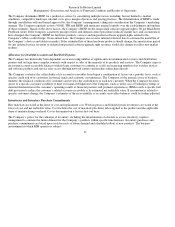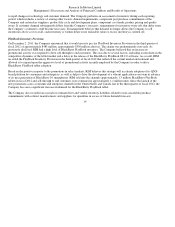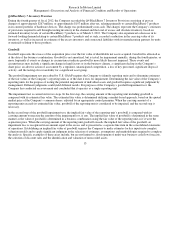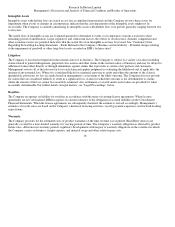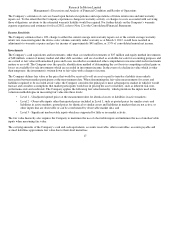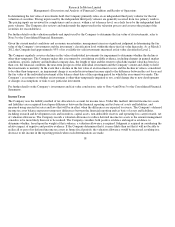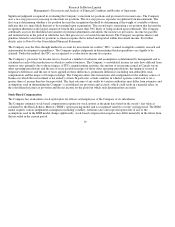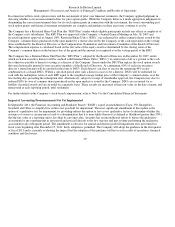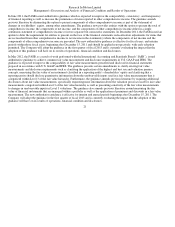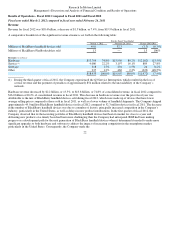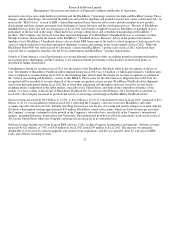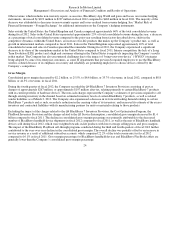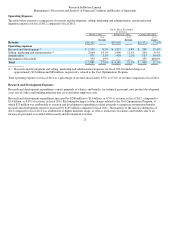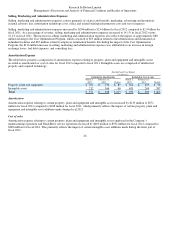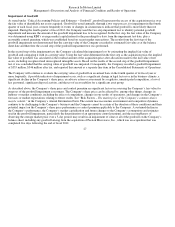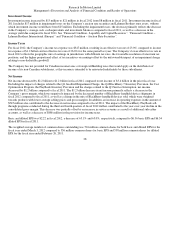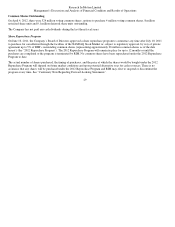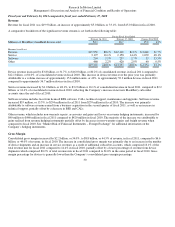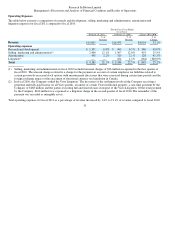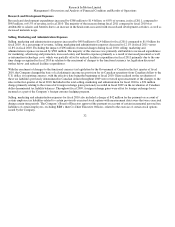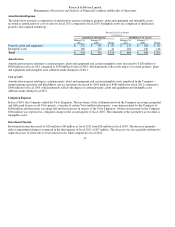Blackberry 2012 Annual Report Download - page 193
Download and view the complete annual report
Please find page 193 of the 2012 Blackberry annual report below. You can navigate through the pages in the report by either clicking on the pages listed below, or by using the keyword search tool below to find specific information within the annual report.
Research In Motion Limited
Management’s Discussion and Analysis of Financial Condition and Results of Operations
decision to develop a new single hardware platform and the BlackBerry 7 operating system for its high-end BlackBerry lineup. These
changes, among other things, affected both the hardware and software timelines and pushed out entry into carrier certification labs. As
noted in the “Risk Factors” section of RIM’s Annual Information Form, there are always risks and uncertainties in new product
development and these changes presented extra challenges to carrier lab entry and the certification process. The mix of BlackBerry
handheld devices in the first and second quarters of fiscal 2012 were heavily weighted towards its BlackBerry 6 handheld devices,
particularly at the low end of the range, which had lower average selling prices and contribution margin than its BlackBerry 7
products. The Company also observed lower than expected shipments of its BlackBerry 6 handheld devices as customers worked
through inventory and awaited the launch of the BlackBerry 7 handheld devices. However, delays in the product introduction
timelines for its BlackBerry 7 handhelds devices also excluded RIM from some of the back-to-school programs it had expected to be
a part of, which resulted in lower than anticipated shipments, revenue and earnings in the second quarter of fiscal 2012. While the
BlackBerry Bold 9900 was well received by customers, certain other BlackBerry 7 product sales in fiscal 2012 were lower than
expected due to competitive launches, the Q3 Service Interruption and BlackBerry 7 product launch delays.
Outside of North America, overall performance was strong although competitive shifts are making growth in international markets
increasingly more challenging, and the Company is not satisfied with the performance of the business in the United States, as
described in further detail below.
Contributing to hardware revenue in fiscal 2012 was the launch of the BlackBerry PlayBook tablet in the first quarter of the fiscal
year. The number of BlackBerry PlayBook tablets shipped during fiscal 2012 was 1.3 million, of which approximately 1 million units
were recognized as revenue during fiscal 2012 as the remaining units did not meet the criteria for revenue recognition as outlined in
the “Critical Accounting and Estimates” section of this MD&A. The revenue for the units that were shipped in fiscal 2012 but not
recognized will be recorded as revenue when all of the revenue recognition criteria are met. BlackBerry PlayBook tablet shipments
were lower than anticipated during fiscal 2012 due to lower than anticipated sell-through to end users caused by several factors,
including intense competition in the tablet market, especially in the United States, and shifts in the competitive dynamics of the
market, as well as a delay in the release of BlackBerry PlayBook OS 2.0 software until February 2012. During the second half of
fiscal 2012, the Company increased its promotional activity to encourage sell-through of the BlackBerry PlayBook tablets.
Service revenue increased by $0.9 billion, or 27.8%, to $4.1 billion or 22.2% of consolidated revenue in fiscal 2012, compared to $3.2
billion, or 16.1% of consolidated revenue in fiscal 2011, reflecting the Company’s increase in net new BlackBerry subscriber
accounts since the end of fiscal 2011. Partially offsetting this increase was the loss of revenue and penalty charges associated with the
Q3 Service Interruption totaling approximately $54 million. BlackBerry tiered service plans, which are lower revenue per user than
the Company’s average, continued to drive growth in the Company’s subscriber base, specifically in the Company’s international
markets, including Indonesia, South Africa and Venezuela. The international growth was offset by particularly weak results in fiscal
2012 in the United States where the Company experienced a net decrease in its subscriber base.
Software revenue includes fees from licensed BES software, CALs, technical support, maintenance and upgrades. Software revenue
increased by $23 million, or 7.8%, to $318 million in fiscal 2012 from $294 million in fiscal 2011. The increase was primarily
attributable to an increase in software upgrades and revenue from acquisitions, and this was partially offset by a decrease in BES,
CALs and software licensing revenue.
23


